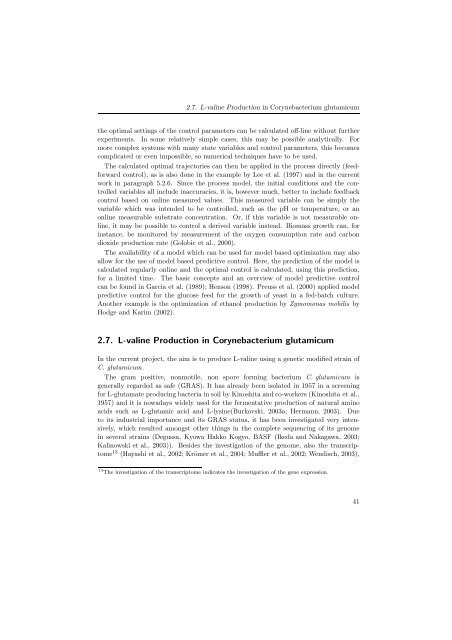Corynebacterium glutamicum - JUWEL - Forschungszentrum Jülich
Corynebacterium glutamicum - JUWEL - Forschungszentrum Jülich
Corynebacterium glutamicum - JUWEL - Forschungszentrum Jülich
You also want an ePaper? Increase the reach of your titles
YUMPU automatically turns print PDFs into web optimized ePapers that Google loves.
2.7. L-valine Production in <strong>Corynebacterium</strong> <strong>glutamicum</strong><br />
the optimal settings of the control parameters can be calculated off-line without further<br />
experiments. In some relatively simple cases, this may be possible analytically. For<br />
more complex systems with many state variables and control parameters, this becomes<br />
complicated or even impossible, so numerical techniques have to be used.<br />
The calculated optimal trajectories can then be applied in the process directly (feedforward<br />
control), as is also done in the example by Lee et al. (1997) and in the current<br />
work in paragraph 5.2.6. Since the process model, the initial conditions and the controlled<br />
variables all include inaccuracies, it is, however much, better to include feedback<br />
control based on online measured values. This measured variable can be simply the<br />
variable which was intended to be controlled, such as the pH or temperature, or an<br />
online measurable substrate concentration. Or, if this variable is not measurable online,<br />
it may be possible to control a derived variable instead. Biomass growth can, for<br />
instance, be monitored by measurement of the oxygen consumption rate and carbon<br />
dioxide production rate (Golobic et al., 2000).<br />
The availability of a model which can be used for model based optimization may also<br />
allow for the use of model based predictive control. Here, the prediction of the model is<br />
calculated regularly online and the optimal control is calculated, using this prediction,<br />
for a limited time. The basic concepts and an overview of model predictive control<br />
can be found in Garcia et al. (1989); Henson (1998). Preuss et al. (2000) applied model<br />
predictive control for the glucose feed for the growth of yeast in a fed-batch culture.<br />
Another example is the optimization of ethanol production by Zymomonas mobilis by<br />
Hodge and Karim (2002).<br />
2.7. L-valine Production in <strong>Corynebacterium</strong> <strong>glutamicum</strong><br />
In the current project, the aim is to produce L-valine using a genetic modified strain of<br />
C. <strong>glutamicum</strong>.<br />
The gram positive, nonmotile, non spore forming bacterium C. <strong>glutamicum</strong> is<br />
generally regarded as safe (GRAS). It has already been isolated in 1957 in a screening<br />
for L-glutamate producing bacteria in soil by Kinoshita and co-workers (Kinoshita et al.,<br />
1957) and it is nowadays widely used for the fermentative production of natural amino<br />
acids such as L-glutamic acid and L-lysine(Burkovski, 2003a; Hermann, 2003). Due<br />
to its industrial importance and its GRAS status, it has been investigated very intensively,<br />
which resulted amongst other things in the complete sequencing of its genome<br />
in several strains (Degussa, Kyowa Hakko Kogyo, BASF (Ikeda and Nakagawa, 2003;<br />
Kalinowski et al., 2003)). Besides the investigation of the genome, also the transcriptome<br />
13 (Hayashi et al., 2002; Krömer et al., 2004; Muffler et al., 2002; Wendisch, 2003),<br />
13 The investigation of the transcriptome indicates the investigation of the gene expression.<br />
41

















